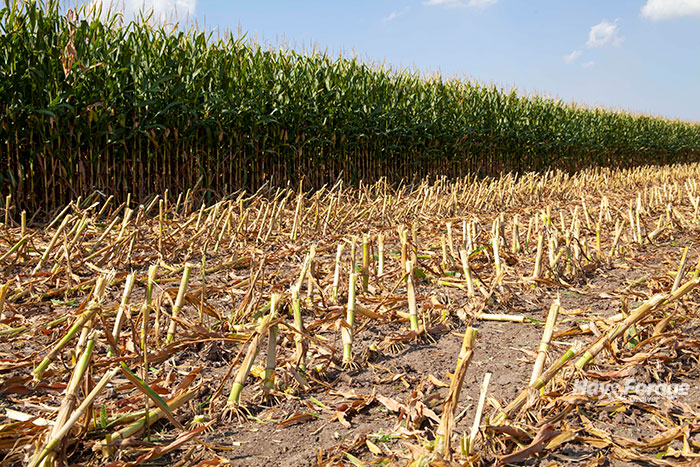
There are some producers who swear by high-chop corn silage while others wouldn’t consider the practice. When it comes to corn cutting height, there is no one-size-fits-all, but ample research has made it clear what the benefits and trade-offs will be. Here’s a quick review of each as we push into the silage harvesting season.
Cutting corn higher will:
1. Lower dry matter yields. When chopping height was raised from 6 to 8 inches to 18 to 19 inches, studies have shown a yield decline of 7% to 15%, which converts to at least a 0.5 ton of dry matter per acre or about 1.4 as-fed tons. If a lack of forage inventory is a limiting factor this year, then high-chop corn silage is not the best strategy.
2. Raise starch content. With the same amount of grain harvested in less stover, it’s no surprise that the starch content of high-chop corn will be higher. Studies have shown that it usually improves by 2 or 3 percentage units, or about 6%. This means less corn grain and more forage can be fed in the ration.
3. Reduce fiber concentration. Fiber constituents such as acid and neutral detergent fiber (ADF and NDF) will be lower because more of the lower stalk is being left in the field. In one summary of 11 high-chop comparisons, ADF was about 2.5 percentage units lower and NDF was 3 percentage units lower.
4. Improve fiber digestibility. With a greater portion of the lignified stalk being left in the field, overall fiber digestibility improves by as much as 5%, or up to 3.5 percentage units.
5. Lower moisture content. The lower stalk is often the wettest part of the standing corn plant. Conversely, the grain is drier than the stover. Both factors contribute to high-chopped corn being drier than low-chopped corn. If your corn is already borderline too dry, high chopping will only exacerbate the problem. Conversely, if the corn is slightly wet but needs to get off the field, high chopping will lower the moisture by 2 or 3 percentage units.
6. Reduce nitrate concentration. Nitrates tend to accumulate in the stalk, especially the lower stalk. Chopping corn high is one approach to lowering the overall nitrate concentration in the silage crop. Nitrate concentrations are usually at their highest level following a rainfall that is preceded by drought conditions. If drought conditions have dominated the growing season, it’s likely that giving up yield by high chopping isn’t going to look too appealing. Also, remember that about 50% of forage nitrate is driven off as silo gas during fermentation.
High-chop corn is a strategy to modify feed quality and moisture. It won’t be appropriate in every situation, especially where harvested yield needs to be maximized. As with brown midrib hybrids, high-chop corn silage will offer the greatest benefit and value when fed to high-producing dairy cows.

